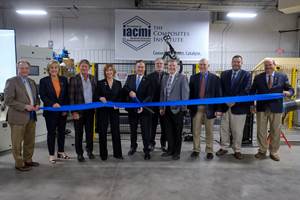Can IACMI propel us out of adolescence, into adulthood?
On Jan. 9, the US Department of Energy (DoE) announced that it will add US$70 million to the US$189 million already committed to the University of Tennessee’s Institute for Advanced Composites Manufacturing Innovation (IACMI) for composites R&D. CW's editor-in-chief Jeff Sloan asks, "What will come of this investment?"
Share
Read Next
The biggest composites news of 2015, thus far, was the Jan. 9 announcement that the University of Tennessee’s Institute for Advanced Composites Manufacturing Innovation (IACMI) had received a highly coveted and much anticipated US$70 million investment from the US Department of Energy (DoE) for composites R&D. The DoE funds will be combined with US$189 million committed to IACMI by the Institute’s partners for a grand total of US$259 million. That’s a lot of dollars.
The big question now is, What will come of this investment?
Stated goals are ambitious: Reduce overall manufacturing costs by 50%, reduce the energy used to make composites by 75% and increase the recyclability to more than 95% within the next decade. One would think that US$259 million could take us a long ways toward meeting these goals.
There are, however, a lot of cooks in the IACMI kitchen. The organization will be led by a group of seven core partners: the University of Tennessee, Michigan State University, Purdue University, the University of Kentucky, the National Renewable Energy Laboratory (NREL), Oak Ridge National Laboratory (ORNL) and the University of Dayton Research Institute (UDRI). Following their lead is a long and diverse list of other partners that includes other universities, institutes, economic development centers and many industry suppliers.
At the top of the IACMI organizational chart is CEO Craig Blue, who will collect the money and manage the partnership’s 122 participants. To give this sprawling enterprise a little structure, he has organized it into five geographic regions, each with a unique focus: Michigan, vehicles; Colorado, wind turbines; Ohio, compressed gas storage; Indiana, design, modeling and simulation; Tennessee/Kentucky, materials and processing technology.
No matter how you slice it, IACMI has its work cut out for it. Composites, as you know, have a lot going for them: High strength and stiffness, light weight, durability, corrosion resistance, parts consolidation. Composites also have a lot going against them, all of which fall under the heading of “different” — different than steel, aluminum and other legacy materials, which are amorphous and isotropic, and for which material data is plentiful, design/simulation software is mature, and processing methods are established. Composites are none of the above. They are processed by widely varied and still comparatively slow means. Data are lacking. Simulation is in its gawky teenage stage, and the polymorphous nature of composites vastly compounds the difficulty of process control, product consistency and manufacturing repeatability.
To those who work with isotropic materials, composites offer a whole new world of potential benefits. But even an experienced designer or manufacturing engineer who is new to composites has few easy-to-use technical resources available to help him or her move comfortably into the world of composites fabrication.
Up to now, this hasn’t stopped progress. Our industry has happily relied on composites’ inherently superior mechanical properties and unique tailorability to overcome the design and manufacturing challenges. But OEMs are signaling that their patience is waning — these hurdles must be lowered if composites are to keep their place at the manufacturing table. We’re hearing this from the aerospace and automotive markets in particular, whose aluminum and steel suppliers have been busy developing new products that offer greater strength- and stiffness-to-weight than before, process in familiar fashion and come at a more economical price point.
Can IACMI propel us out of adolescence into adulthood? Its size and the scope of the partnership seem to make it a good candidate. In any case, evolution is now a necessity, and someone must lead the way. John Byrne, Boeing’s VP of aircraft materials and structures, put it this way at CW’s Carbon Fiber 2014 conference in December: “The composites industry needs to grow up, and fast.”
Related Content
IACMI receives funding renewal from U.S. DOE to continue composites R&D
Over the next five years, IACMI aims to further composites R&D efforts to support U.S. decarbonization and its pillars: technology, economy and workforce development.
Read MorePeople in composites: April 2023
Concordia Engineered Fibers, Nawa Technologies, IACMI, Joby Aviation and Akarmak America have made new personnel announcements in April 2023.
Read MoreRead Next
Plant tour: Daher Shap’in TechCenter and composites production plant, Saint-Aignan-de-Grandlieu, France
Co-located R&D and production advance OOA thermosets, thermoplastics, welding, recycling and digital technologies for faster processing and certification of lighter, more sustainable composites.
Read MoreVIDEO: High-volume processing for fiberglass components
Cannon Ergos, a company specializing in high-ton presses and equipment for composites fabrication and plastics processing, displayed automotive and industrial components at CAMX 2024.
Read MoreAll-recycled, needle-punched nonwoven CFRP slashes carbon footprint of Formula 2 seat
Dallara and Tenowo collaborate to produce a race-ready Formula 2 seat using recycled carbon fiber, reducing CO2 emissions by 97.5% compared to virgin materials.
Read More




















